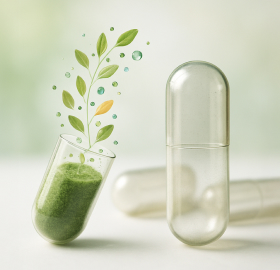Imagine a world where the colors in your capsules are as natural as the ingredients they contain. With growing consumer demand for clean labels, colorants derived from natural sources have become a vital component in the nutraceutical industries. But what exactly are these colorants, and why should you care?
Introduction to Natural Colorants in Capsules
What are Natural Colorants?
Pigments obtained from plants, minerals, and seeds offer a more natural alternative to synthetic dyes, which are produced through chemical processes. Extracted directly from nature, natural colorants are a healthier option for consumers and more sustainable for the environment. In the nutraceutical industry, they are used to highlighting brand or product qualities through the use of color without compromising the safety or integrity of the product.
The Importance of Natural Colorants in Today's Market
In a world where consumers are increasingly informed and concerned about what they consume, natural dyes have gained relevance. Especially in the nutraceutical industry, where purity and transparency are essential, the use of these colorants has become a new standard. Capsules containing them not only meet this demand, but also support the clean labeling trends dominating the market.
Natural Colorants in Capsules: A Detailed Overview
What are Capsules with Natural Colorants?
Capsules with natural dyes are manufactured using pigments extracted from sources such as plants, seeds and flowers, rather than synthetic dyes. These natural dyes not only respond to consumer preference for healthier and more sustainable products, but also comply with international regulations on natural product labeling.
Capsules made with natural dyes, like K-CAPS® HPMC, are perfect for companies that want to highlight their commitment to transparency, ingredient purity, and sustainability. Opting for vegetarian capsules made with natural colorants demonstrates an effort to offer products that are as natural as possible. Vegetarian capsules offer health-conscious consumers a natural alternative to animal-based capsules. In addition, these capsules are free of preservatives, allergens, and starches, and are Non-GMO, Kosher and Halal certified. Additionally, some colors used in K-CAPS® are Registered by the Vegan Society.
Common Natural Colorants Used in Capsules
We use a variety of colorants in the manufacturing process of our K-CAPS capsules, carefully selected and treated to obtain colors in a natural way. Each of these colorants not only brings a vibrant hue to the capsule, but also ensures the integrity and naturalness of the final product.
Get to know the colors we manage and their origins:
- Annatto (Bixa Orellana) : Annatto natural colorant is derived from the spiny pods of annatto seeds using an aqueous alkali extraction. The pH is adjusted with potassium hydroxide, and the solution is spray-dried with glucose syrup and maltodextrin as carriers.
- Jagua Blue (Genipa americana): Jagua Blue natural colorant is derived from the Genipa americana fruit through aqueous extraction. It provides a deep, stable blue hue and offers a clean-label alternative to synthetic colorants for nutraceutical and pharmaceutical applications.
- Brown Carrot (Caucus carota L. and Daucus carota ssp. Sativus var. atrorubens) : The brown carrot natural colorant is not derived from brown carrots but from purple and black carrots. Citric acid is added at harvest to control pH, and the colorant is then concentrated and dried without using any carriers.
- Caramel : Caramel natural colorant is produced by the controlled heating of plant-based glucose in the presence of ammonium sulfite, resulting in a liquid colorant.
- Purple Sweet Potato (Dioscorea alata) : Purple sweet potato natural colorant is derived from purple sweet potatoes. Citric acid is added during harvest to control the pH. The colorant is then concentrated and dried without the use of any carriers.
- Red Radish (Raphanus sativus) : Red radish natural colorant is made from red radishes. Citric acid is added during harvest to regulate the pH. The colorant is then concentrated and dried without any carriers, resulting in a non-hygroscopic and easily soluble product.
- Safflower (Carthamus tinctorius) : Provides a yellow-orange hue derived from the seeds of the safflower plant.
- Spirulina (Arthosphira Platensis) : Spirulina natural colorant is derived from Arthrospira platensis, an edible blue-green algae. It is extracted using water and then spray-dried to produce a powder.
- Annatto + Spirulina (Bixa Orellana + Arthosphira Platensis) :The fusion of Bixa Orellana (annatto) and Arthospira Platensis (spirulina) results in an ideal green hue for dietary supplements and vitamins, leveraging the unique characteristics and advantages of both ingredients.
- Vegetable Carbon: Vegetable carbon colorant is derived from carbonized plant materials like wood, cellulose residues, peat, and shells. The process involves carbonization, milling, cyclone treatment, acid washing, neutralization, and drying.

If you are considering ordering K-CAPS with natural pigments, our manufacturing facilities can prepare samples for your evaluation. These color samples are made from the same HPMC material used in the manufacture of the capsules. This will allow you to see precisely how your chosen color will look on your vegetarian capsules and give you the opportunity to test their masking ability.
The Benefits of Using Capsules with Natural Colorants
The use of capsules with naturally extracted colorants offers multiple benefits. These capsules respond to the growing demand for more natural and sustainable products for manufacturers. They also help to improve brand perception, associating it with health and wellness values. For consumers, they represent a safer and more transparent option, aligning with the trend of seeking products with clean labels and no artificial ingredients.
Natural Colorant Capsules: Practical Considerations
Do Capsules Have Dye in Them?
Yes, capsules may contain colorants, but it is important to distinguish between synthetic and natural colorants. While synthetic dyes are composed of chemicals, natural dyes are derived from sources such as plants, seeds and flowers. Choosing capsules with natural colorants is a healthier option, as it minimizes exposure to artificial additives.
Factors to Consider When Choosing Natural Colorant Capsules
When choosing capsules, it is essential to consider factors such as color stability, shade variability by production batch and packaging requirements. These colorants may be more sensitive to light and heat, which can affect their appearance if not stored properly. In addition, color consistency may vary slightly due to natural differences in naturally sourced raw materials.
Best Practices for Using Capsules with Natural Colorants
How to Ensure Quality and Consistency
To ensure quality and consistency when working with these colorants in capsule manufacturing, it is crucial to strictly control production and storage conditions. Using reliable suppliers and performing quality tests on each batch can help maintain color consistency and the integrity of the final product.
Regulatory Considerations for Natural Colorants
Regulations vary by region, so it is essential to ensure that the colorants used comply with local and international regulations. This includes verifying that the colorants are approved for nutraceutical use and that quality and safety standards are met.
Where to Source High-Quality Natural Colorant Capsules
When selecting a capsule supplier, it is crucial to choose one that not only complies with regulations, but also offers quality certifications and customization options to suit your specific business needs. We distinguish ourselves as a trusted supplier, with a proven track record of compliance and a unique ability to ensure that your capsules not only meet consumer expectations, but also meet the most stringent industry standards. Our focus on quality and customization makes CapsCanada an ideal choice for companies looking to integrate natural colorants into their products safely and effectively.
Why Choose CapCanada for Your Natural Colorant Capsules?
We are leaders in the production of capsules with natural colorants, complying with the strictest industry standards. We offer customization options that adapt to each customer's specific needs, guaranteeing a homogeneous and attractive appearance in each capsule thanks to the high quality of the colorants used.
In addition, we are the only ones in the industry to offer a wide variety of TiO2-free colors. Our colors can be combined and customized according to customer preferences, allowing total flexibility in the design of your products.
Conclusion: Embrace the Future of Clean Label Supplements
The future of capsules with natural colorants is promising. With growing awareness of health and wellness, more and more consumers are demanding products that are as pure as they are effective. Adapting to this trend is a way to stay competitive and contribute to a healthier and more sustainable market.















